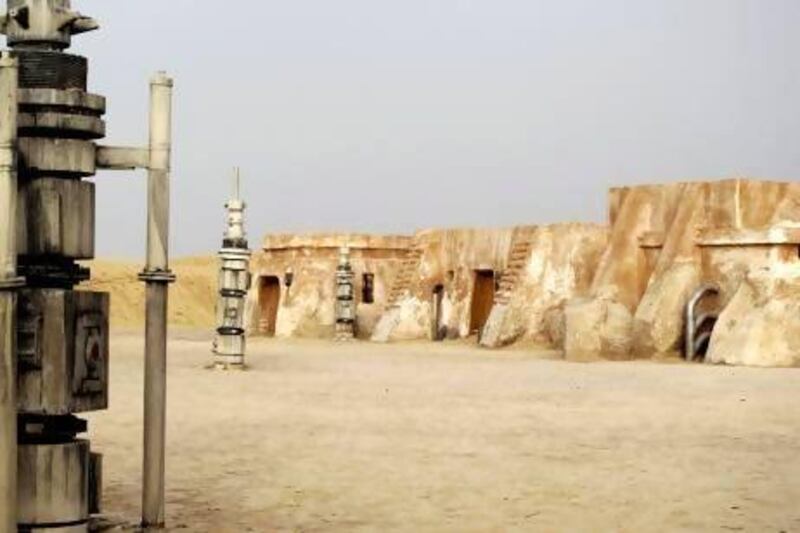When Rä di Martino's photographs of Luke Skywalker's crumbling, dilapidated home from the original Star Wars film started to appear in the American national press, an alarmed group of Star Wars fans started crowd-funding on Facebook to get out to this remote part of the Chott el Djerid desert in Tunisia to spend US$11,000 (Dh40,370) and four days restoring it to its former igloo-like glory. Such is the strength of the nostalgia that resonates through so many people's childhood memories, for something which is essentially a fake fantasy.
It is this power through memory that first drew di Martino to this graveyard of film sets out in the desert. "I find it interesting how all the media and movies that have filtered through our childhood have become as strong a memory as real memories. It's possible to have nostalgia for a place that doesn't exist," she explains.
Having been on the move for most of her life, through Italy, the US, Europe and Africa, di Martino is perhaps suggesting that these fake homes could be, in a way, more real than any home she has experienced.
When the curators Piero Tomassoni and Noor Kadhim were first conceptualising their idea to present an exhibition bringing together eastern and western artists in a show about the relationship between fiction and reality and the concept of home, di Martino was the first natural choice for the Western element.
In the resulting show (Dis) Orient, at Sumarria Lunn Gallery in London, alongside her images of bizarre film set ruins, including Mecca, Ancient Greece and Ancient Egypt, runs di Martino's video, a Wim Wenders-esque short film shot in the desert, incorporating the ruins of an American gas station set, once used in a horror flick, an Arab flautist and boys from a Kasbah close to this incongruous place, reciting lines from Lawrence of Arabia, part of which was filmed here. All of these components serve to disorientate the viewer and push them to look deeper into the ideas of memory and home.
Positioned in sharp contrast to the Italian born di Martino's work is that of the exiled Iraqi Nedim Kufi, who currently resides in the Netherlands. Although not an architect, Kufi says his artistic dreams are based in the geometry of architecture and cites Hassan Fathy, the noted Egyptian architect, as his main influence.
In the exhibition, Kufi presents 10 wooden structural models of his underground Nether homes, a projected urban habitation solution for his native Iraq. Mapped onto the models are the young, bright, hopeful faces of Iraqi primary school boys, from a found 1970s photo album.
"In my mind, these pictures represent a longing for tolerance, acceptance and equality in a country that in recent years has known so little of these things," Kufi says. Not knowing even if these boys are still alive after the turmoil of past years, Kufi is inspired by these images from the golden age of Iraq and presents them as potential owners of his peaceful, bunker-like homes. The models are accompanied not only by rough hand-drawn sketches and expressive, de-focused black and white oil paintings, but also a set of small black and white photographs, found in a book by the Dutch photographer Frank Scholten, who had travelled to Jaffa in Palestine in the 1930s.
Kufi was fascinated by these images and the curious triangle created between himself, the Dutch photographer and the Middle East, specifically Palestine and Iraq, both of which embody the idea of displacement and unrest.
Piero Tomassoni, one half of the curating duo explains: "Here, evidence of the Jaffa residents' existence is framed within the perception of those who never knew them in a relationship that simultaneously affirms and subverts the Orientalist notion of the 'other'." The images are made even more arresting by the addition of dried Dutch flowers pressed on by Kufi.
A boy depicted sitting on a wall in one of these photographs coincidentally reflects one of the boys from Martino's video, also sitting on a wall in one of the ruined sets, reciting lines. Such coincidence is perhaps not surprising, as despite the obvious difference between the two artists' work (Martino's being very much based in the artifice of a media affected, fictional, decaying world and Kufi's in a politically charged, historically grounded one), there are obvious analogies to be drawn between the two.
Kufi says that on seeing Martino's work, he felt a connection: "I felt her soul strongly through her work. Although there is a distinct contrast, I feel we are heading towards the same goal, there is no intersection, but we are working in parallel. There is common ground between us - or a common desert if you like."
(Dis) Orient is an intelligently curated exhibition, with plenty of scope to fulfil the curating duo's desires to create a continuing project. It opens up a long-awaited creative and constructive dialogue between radically different artists, coming from divergent backgrounds and cultures. It gently encourages viewers to challenge their preconceptions of eastern and western art and understand how the two can be appreciated together, in finding the "common desert" that Kufi speaks of.
(Dis) Orient is on show at Sumarria Lunn Gallery in London from today untilJune 28. Visit www.sumarrialunn.com





